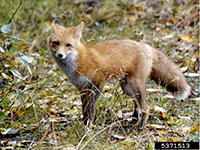

This surge in demand threatens to wipe the bobcat out of America. The interest in Bobcat pelts today was declining due to international awareness of the cruel methods of trapping and prohibitions against trade of animals trapped using these methods up until 2008 when Russia began buying all the bobcat pelts they could get their hands on.

This also caused the number of Bobcats killed annually to rise from 10,000 to over 90,000 by the 1980s. In the 1970’s CITES went into effect and the pelts of the Appendix 1 cats became illegal and unobtainable, the price offered to trappers for a Bobcat pelt went from $20.00 to $600.00. Principal Threats: This little cat was the most heavily harvested and traded member of the cat family for the past 20 years. Their primary diet is rabbit, but they also eat rodents, beaver, peccaries, birds and bats, and deer. Hunting and Diet: These tough little cats will eat almost anything, and are natural born survivors (except for man’s interference). Hear our purrs, hisses, snarls, calls, and growl sounds HERE Males and females only come together at the breeding season, which is December to April. Male territories will overlap that of many females and even to some extent another males, but female territories are exclusive. Social System and Communication: Solitary. In the wild, Bobcats live 12-13 years, and at Big Cat Rescue they have lived over twenty years. They are weaned between 3-4 months of age, and reach sexual maturity around 12 months for females, and 24 months for males. They weigh 9.75-12 ounces at birth and will open their eyes at around 6 days. Reproduction and Offspring: After a gestation of approximately 50-70 days, females produce a litter of 1-8 kittens, with the average being 2-3. Habitat: Boreal and coniferous mixed forests, hardwood forest, coastal swamps, desert and scrubland.ĭistribution: United States and Southern Canada. The tail of the Lynx looks as though it was dipped in an inkwell being black all the way around, whereas the Bobcat’s tail appears to have been painted black on top and white on the bottom. They are often confused with their larger feline cousin the Lynx, but can be easily distinguished by their tail tips. Both melanistic and albinistic Bobcats have been reported, but the melanistic ones have only occurred in Florida. The southern Bobcats seem to have a more spotted coat, with the spots being much smaller than the northern cats. They are always spotted to some extent, with some patterned only on the undersides, and others having spots on the sides and chest backs too. Their coat color varies and has been recorded in shades of light gray, yellowish-brown, buff-brown, and reddish-brown. The bobcats in the North tend to be larger than those in the south. They weigh between 13-30 pounds, stand 21 inches high and are 30-50 inches long. Size and Appearance: The Bobcat is a medium sized cat with a ruff of fur around the sides of the face. Misc: This cat is named for its short tail.


 0 kommentar(er)
0 kommentar(er)
